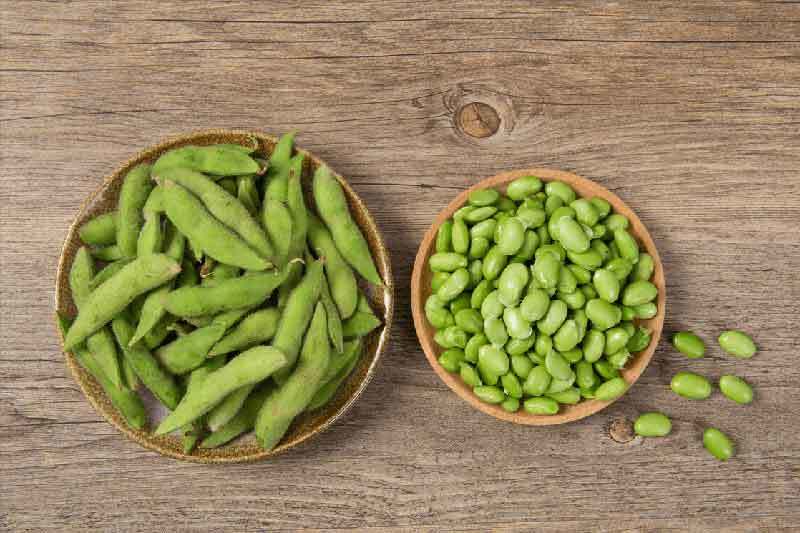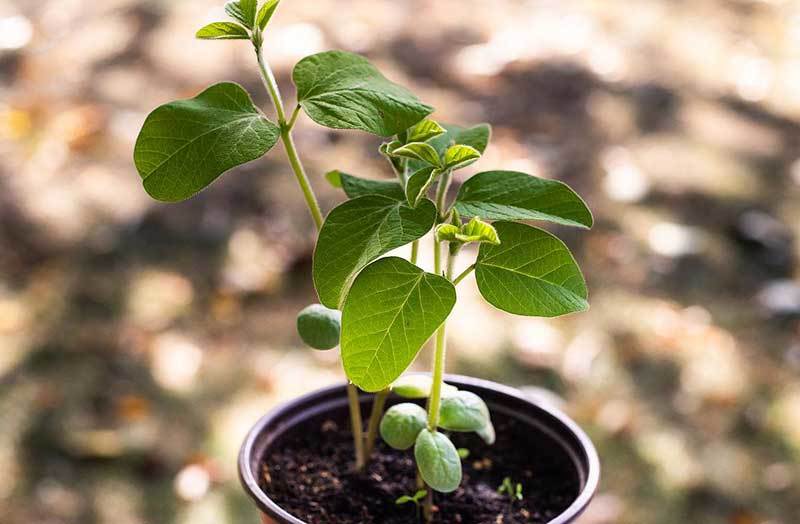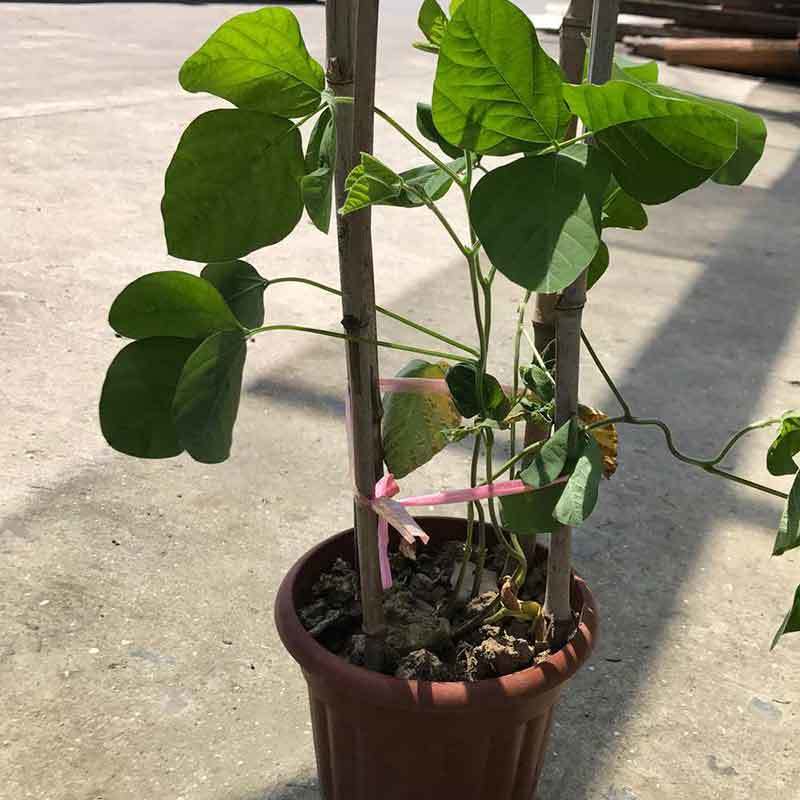A Guide to Growing Edamame in Pots: Tips for a Bountiful Harvest
Introduction
Edamame is a delicious and nutritious legume. Growing edamame in containers has become popular in recent years. It’s an excellent source of protein, vitamins and minerals. Growing your own edamame at home offers many benefits, such as space-saving and convenience.
We will provide you a comprehensive guide to growing edamame in pots. You can enjoy fresh, home-grown edamame any time! You will enjoy this delicious legume by growing edamame beans in pots. You can have a bumper crop of edamame with some planning and care.
Selecting the Right Varieties
Popular edamame varieties: The two most popular types of edamame are green and black. Green edamame has a mild flavor. It is typically ready to harvest in 70-90 days after planting. Black edamame has a sweeter and nuttier taste. It needs around 80-100 days to reach maturity.
Characteristics to consider: You should consider size when picking an edamame variety for container gardening. Small plants have fewer pods but require less space. So they are better suited for plastic nursery pots with limited room. On the other hand, large plants usually produce more pods but need larger vessels to accommodate their growth.
Flavor profile is also an important factor when choosing the right edamame for container gardening. You can choose green edamame if you prefer a mild taste. Black edamame is best if you are looking for something with a sweeter and nuttier flavor.
Recommendations: You should consider both the climate and personal preference when growing edamame from seed. Green edamame may be a better option if your area has colder winters. Because it matures more quickly than black edamame.
Black edamame might be more suitable if your region experiences milder winters or longer growing seasons. Your container garden will produce delicious and nutritious results with a bit of care and love.

Choosing the Right Containers and Soil
As with any type of gardening, having the right container and soil is essential for successfully growing edamame plants in pots. There are several options to choose from when growing edamame in pots, such as standard pots, fabric grow bags, or elevated planters.
Container options: Plastic pots are relatively inexpensive and have different sizes. Grow bags offer more flexibility when positioning your plants. But they take up more space than traditional pots. Elevated planters provide better drainage since the soil is off the ground. But they require more maintenance due to their height above the ground.
Adequate drainage: You should make sure the container has adequate drainage. Edamame does not like to sit in wet soil for a long time. It will quickly succumb to root rot if the soil is too soggy. You can use containers with multiple holes in the bottom for maximum drainage.
The ideal soil composition: Edamame prefers a nutrient-rich soil mix with good aeration and moisture retention. A mixture of equal parts organic compost, potting soil and sand works well. You can add peat moss, expanded perlite or composted manure to increase drainage and aeration in heavier soils.
You can add some slow release fertilizer or other amendments to provide additional nutrients for your plants, such as worm castings or kelp meal. Be sure to mix these ingredients thoroughly before planting edamame in pots.
Edamame does not tolerate extreme fluctuations in temperature or moisture. So ensure the soil mix remains moist and warm. You can add some insulation to help regulate the temperature if you're using containers with plastic or clay walls.
How to Grow Edamame in Pots?
When to plant edamame? The optimal time to sow edamame bean seeds is in early spring, when soil temperatures reach around 65°F (18°C). You can grow edamame at home a few weeks ahead. Or growing edamame in garden as soon as the weather warms up outdoors.
Edamame planting instructions: When sowing edamame seeds in containers, prepare your potting mix first according to the instructions on the package. Fill your planting container with at least six inches of soil. Use small plastic nursery pots if you plan on transplanting when the seedlings become larger. Add fertilizer or compost before you place your seeds onto the soil surface.
Cover the seeds with about 1/4 inch of soil. Press them down with your finger lightly. Water the newly planted edamame seeds gently but thoroughly. Using a watering can or a garden hose. As the edamame germination, water regularly, keeping the soil moist but not soggy.
Tips for successful sprouting: Edamame seed germination times vary among varieties, so consult the package for specific timing details. You should transplant them into big plastic planters when your edamame sprouts have two sets of leaves each.
To ensure they’re getting adequate sunlight and ventilation, rotate the pots around every few days. This can avoid leggy plants due to lack of light exposure. If you’re worried about pests or diseases, cover the plants with a row cover. Use an organic insecticide or fungicide to protect them.
Pull away any weeds that appear. Give them occasional fertilizer boosts throughout the edamame growing season. Your edamame will harvest in late summer or early fall with proper care and attention.
Edamame Plant Care and Maintenance
Edamame, a type of immature soybean, is becoming an increasingly popular vegetable. If you want to grow edamame in pots, you should provide the right conditions for successful growth. Here’s how:
Sunlight and temperature requirements: Edamame plant in pot requires full sun — at least six hours per day — for optimal growth and production. When the edamame growing temperature is cooler (below 65°F) or if there’s not enough sunlight, the plants will be stunted and won’t produce as much yield. In hotter climates, providing some shade during the hottest part of the day. This can help keep the plants from wilting and going dormant.
Water Requirements: Edamame needs to be consistently moist, but not waterlogged, for best growth. You’ll need to check the soil moisture every couple of days and make sure it isn’t drying out too much. If the soil is dry to the touch an inch below the surface, it’s time to water your plants.
Fertilization Needs: Edamame is a legume and can fix nitrogen from the air into its roots. But it still requires additional fertilizers to produce a good yield.
You can use a balanced organic fertilizer to provide nutrients throughout the growing season, like fish emulsion or compost tea. Make sure not to over fertilize. Because this can lead to a high concentration of nitrogen in the soil and can stunt edamame’s growth.
Weed Control: You should keep the area around your edamame plants weed-free for optimal growth. Without weeds competing for water, nutrients and sunlight, your edamame will have an advantage when producing a good yield.
The best way to keep weeds away is by using mulch and maintaining regular weeding. You may also want to consider putting up a fence or trellis system around the container garden to keep out larger pests like rabbits and deer.

Managing Pests and Diseases
Common pests: When growing edamame in pots, you should keep an eye out for pests and diseases. Aphids, thrips, slugs, caterpillars, beetles and spider mites are common edamame pests. You can control these pests with natural sprays, such as neem oil or insecticidal soap solutions.
Companion planting is also an effective deterrent. Marigolds help repel nematodes and other garden pests from edamame plants. Garlic can ward off mosquitos. Finally, use a fertilizer specifically formulated for legumes to ensure optimal nutrition for your plants.
Common diseases: The diseases affecting edamame plants include bacterial blight, powdery mildew and fusarium wilt. To prevent these diseases from occurring, rotate crops every year. So that the same plants are not grown in the same location.
Clean up any debris or fallen leaves to reduce the number of diseases. Because they may cause fungi and bacteria in the soil. Pick off infected leaves as soon as you spot them. You can water your edamame plants at ground level instead of from overhead. This will help prevent moisture on the leaves which can lead to fungal infections.
Pruning and Training
The benefits of pruning edamame plants in pots: Firstly, it encourages the plant to grow more bushy and full, with a balance between the upper canopy of leaves and lower foliage. This is especially beneficial when growing edamame in containers. Because the space to support plant growth is limited.
Regular pruning also helps remove any dead or diseased branches. This can help prevent health problems from spreading throughout your edamame plants. Lastly, pruning can increase productivity by allowing for more light exposure on all parts of the plant, promoting photosynthesis on both sides of each branch.
Proper pruning techniques: Firstly, make sure your pruning shears are sharp and clean. Don't damage the plant when cutting. Secondly, you should avoid pruning too much of any single branch or leaf. Because this could create unbalanced growth and excessive stress on the plant. When possible, try to cut at an angle and form a v-shape between adjacent branches for more efficient light absorption and air circulation.
Training edamame plants: It is also an option available to gardeners looking for greater productivity from their plants. This involves creating structures such as trellises or cages around the edamame plants. This can provide support for their stems but still allow them enough room to grow freely without becoming overcrowded.
Training edamame in pots helps to give them a more compact and orderly shape. This will turn easy their management and allow for better air circulation and light exposure. Furthermore, it can result in higher yields of edible beans thanks to the increased number of branches and leaves available for photosynthesis.
Harvesting and Storage
When to harvest edamame? You can harvest edamame plants when the pods turn bright green and become slightly firm. The seed pods will start to dry out or split open if you wait too long. This will reduce their quality.
How to harvest edamame? When harvesting edamame beans, you should pick only what you will eat right away. Because edamame has a relatively short shelf life after being picked. To harvest, simply snap off the whole stem with your fingers or use a pair of garden shears. Be careful not to damage any of the other branches. Because this can hinder the plant's ability to produce future growth.
Storage techniques: You should store them correctly to ensure your edamame remains fresh and tasty. Refrigerated edamame should not come in contact with any moisture or air. Because this will cause the pods to spoil quickly. Freezing can extend the shelf life of edamame. You should cook them within a few days once thawed.

Troubleshooting Common Issues
Growing edamame in a pot is a rewarding experience, but not without challenges. You may encounter some common problems during your growth process. For example, yellowing leaves, stunted growth or an infestation of pests. These troubleshooting tips can help keep your plants healthy and productive.
Yellowing leaves: This may be over-watering or nutrient deficiencies if you notice yellowing leaves on your edamame plants. You should ensure the pot has sufficient drainage holes in the bottom. Try watering only when the top inch of soil is dry.
The fertilizer should contain all essential macro and micronutrients needed for optimal plant health. Test your soil's pH level once a month. Apply fertilizer accordingly if possible.
Stunted growth: Stunted growth is another common issue. Particularly if the soil is too compact or there's not enough sunlight. So you can lose up the soil around the plant using a trowel. Put them in an area which has 6-8 hours of direct sunlight each day.
Pests infestation: Pests like aphids is another problem when growing edamame in pots. You can apply insecticidal soap or organic neem oil spray once every two weeks. Cover all parts of the plant during application. Repeat as necessary. You can also use beneficial insects to help control the population naturally. For example, ladybugs or lacewings.
Frequently Asked Questions
Do I need to start edamame from seed or can I buy plants?
You can purchase edamame plant for sale and plant them directly. You will save lots of time. You can grow edamame from seed if you want to try growing new varieties in the season.
Where can I find edamame seeds?
You can usually buy edamame seeds at any garden center or online retailer. They have different gardening supplies and edamame seeds for sale. You should buy certified organic, non-GMO varieties for the best quality plants. You can also ask your local nursery if they carry edamame seeds for planting.
How long does it take edamame to ripen?
Edamame plants typically take approximately 8-10 weeks to reach maturity. However, this may vary depending on the variety, type of soil used and edamame growing conditions. For example, temperature and humidity. Additionally, you should plan on harvesting your edamame crops before they become too mature. Otherwise, the bean pods will be tough and not as flavorful.
Can I save the edamame seeds for planting next season?
Yes, you can save some of the mature pods from this season’s harvest to use as seed for future crops. Carefully remove the seeds from their shells. Spread them out on a dry, dark surface to thoroughly dry. Store the seeds in a sealed container in a cool and dry place when they’re completely dry.
Conclusion
Edamame has a delicate flavor and wealth of health. Growing edamame in pots is an easy route to enjoying delicious harvests. The potting mix should be nutrient-rich and good drainage. You should create a regular watering schedule to keep your edamame healthy. This can keep the soil moist but not soggy.
You need to fertilize them every few weeks with a balanced fertilizer formula. Edamame plants in pots are particularly vulnerable to pests and disease. So inspect them regularly and use appropriate treatments if needed.
You can enjoy a bountiful harvest with the right care. So get out there and grow your own edamame now. You will have a bountiful harvest of delicious edamame by following this edamame growing guide!
Container gardening gives you more control over soil, water, and space. Explore more tips and plant guides in our Grow Plants in Containers hub.
Related Article:
growing tomatillos in pots
growing squash in pots



